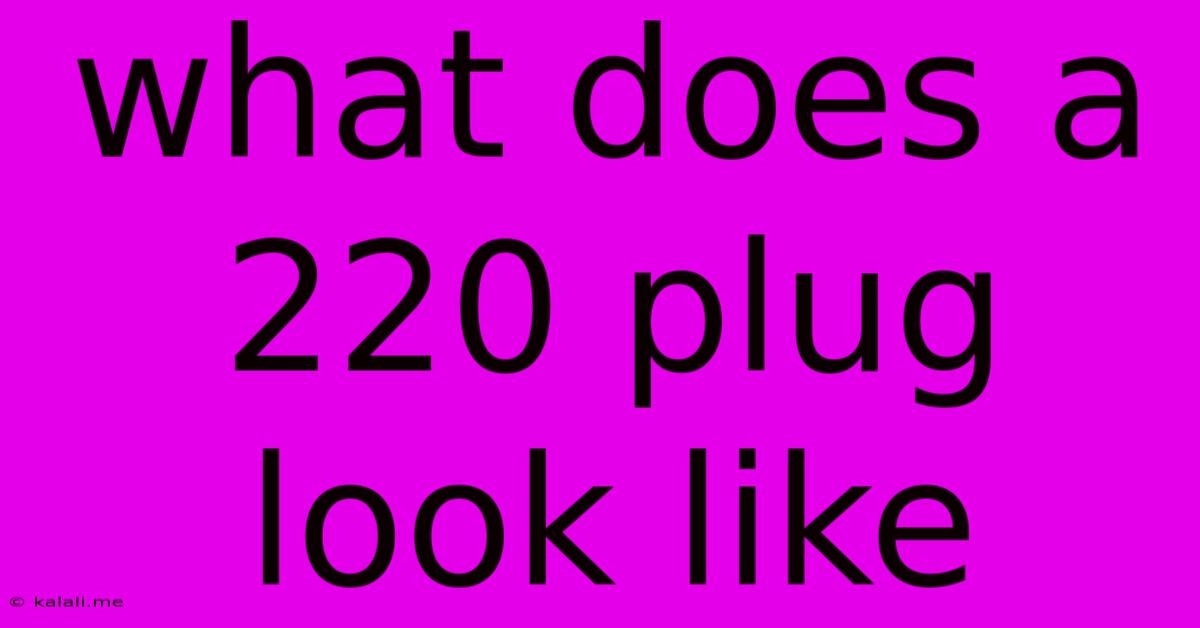What Does A 220 Plug Look Like
Kalali
Jun 08, 2025 · 3 min read

Table of Contents
What Does a 220 Volt Plug Look Like? A Comprehensive Guide
Meta Description: Confused about what a 220-volt plug looks like? This guide provides images and descriptions of common 220-volt plug types worldwide, explaining their differences and safety features. Learn to identify them easily!
A 220-volt plug, also known as a 220V plug, 230V plug, or even 240V plug (depending on regional voltage variations), differs significantly from standard 120-volt plugs commonly used in North America. Understanding what these plugs look like is crucial for safety and compatibility when traveling internationally or working with high-voltage appliances. The appearance varies widely depending on the country and regional standards. There's no single "220-volt plug."
This guide will explore the visual characteristics of common 220-volt plug types, highlighting key differences and helping you identify them effectively.
Why the Variety in 220 Volt Plugs?
The variations in 220-volt plug designs stem from differing national and regional electrical standards. These standards dictate factors like:
- Voltage: While generally around 220-240 volts, slight variations exist.
- Current: The amperage supported by the plug and socket impacts the size and design.
- Safety features: Grounding pins, insulation, and other safety mechanisms differ across standards.
Common Types of 220-Volt Plugs and Their Appearance
Several plug types are commonly associated with 220-volt power. While it's impossible to cover every variation, here are some of the most prevalent:
-
Type C (European plug): This is perhaps one of the most widely recognized 220-volt plugs. It's characterized by two round pins, typically spaced 19mm apart. It often lacks a grounding pin, relying instead on double insulation in the appliance itself. Think of the standard European travel adapter.
-
Type E/F (French/Belgian plug): Similar to Type C, but includes an additional grounding pin, typically located on the top or bottom of the plug.
-
Type G (British plug): Easily identifiable by its three rectangular pins—two larger pins and a smaller grounding pin. This plug type features a fuse built into the plug itself, enhancing safety.
-
Type I (Australian/New Zealand plug): Recognizable for its two flat, parallel pins with a grounding pin situated at the top, angled outwards.
-
Type J (Swiss plug): Features a unique shape with two round pins.
-
Type N (Italian plug): It has three round pins and is frequently found in the Mediterranean region.
Important Note: Images are crucial for accurate identification. A quick Google image search for "Type [Plug Type] plug" will provide visual confirmation of the descriptions above. Always check the specific plug type before attempting to use any appliance.
Safety Precautions when Dealing with 220-Volt Plugs
Working with 220-volt power requires extra caution. Here are some essential safety measures:
- Never attempt to force a plug into a socket if it doesn't fit. Using an incompatible adapter or plug can lead to electrical shock or fire.
- Always ensure that appliances are properly grounded, if the plug and socket support it.
- Inspect plugs and sockets for damage before use. Worn or damaged components should be replaced immediately.
- Turn off power before handling electrical connections.
- If you are unsure about anything, consult a qualified electrician.
Understanding the visual differences between 220-volt plugs from various regions is paramount for ensuring safe and effective use of high-voltage appliances. Always prioritize safety and double-check compatibility before plugging in any device. Remember to consult reliable resources and utilize visual aids for confident identification.
Latest Posts
Latest Posts
-
Cast Out Demons In My Name
Jun 08, 2025
-
Are Yellow And Gold Potatoes The Same
Jun 08, 2025
-
What Electronics Component Would Fade An Led Light Bulb
Jun 08, 2025
-
Why People Say To Quit Repeat Everything Someone Says
Jun 08, 2025
-
How To Remove Door Knob Schlage
Jun 08, 2025
Related Post
Thank you for visiting our website which covers about What Does A 220 Plug Look Like . We hope the information provided has been useful to you. Feel free to contact us if you have any questions or need further assistance. See you next time and don't miss to bookmark.